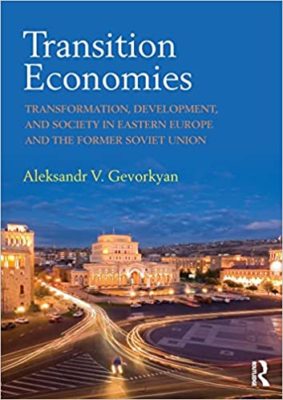Anyone interested in the post-Soviet space — whether general reader, sociologist or seasoned economist — will find something of interest in Aleksandr V. Gevorkyan’s Transition Economies. Gevorkyan goes over in detail the changes that have affected both the former republics of the USSR and their Eastern bloc counterparts (Romania, Bulgaria, Hungary, Poland, etc.) that transitioned from planned to market economies between the 1990s and today. Gevorkyan clearly explains from the beginning that this vast region includes 29 countries, each one with a distinct culture and traditions that have affected how successfully they have made this transition. In Chapter Two, Gevorkyan discusses what the transition from one type of economy to another was originally supposed to look like conceptually and asks what constitutes a successful change: Is it simply economic change or does it include broader societal changes?
Another great strength of the book is that Gevorkyan accompanies his findings by detailed prose commentary. Along with contemporary statistics and findings, he also provides a historic overview of the development of socialism itself and the performance of Soviet and Eastern-bloc socialist economies over the past century. The author goes back to the Russian Revolution and the rise of the Bolsheviks, through the NEP (New Economic Policies) and five-year plans. Not surprisingly, he finds that these economies did sensibly better than they are often credited with in the West, while falling short of expectations set by the Supreme Soviet and other planners who were unable to develop the hoped-for socialist paradise at the turn and middle of the 20th-century. In counterpoint, he also notes that economic output in some of the countries analyzed dropped more than 40 percent after the fall of the USSR and command economies, and that it has taken some 30 years for several of the countries examined to reach their previous levels. Unlike some economists, Gevorkyan does not gloss over the extreme poverty that some of these countries were thrown into during the transition to capitalism or the social problems that accompanied the latter, including the crumbling of traditional family structures and mass emigration. In the last two chapters of Transition Economies, he notes that factors such as high domestic demand and an increase in commodity prices have helped to regulate and improve some local economies, though others have still not reached hoped-for levels of development.
A professor of economics at St. John’s University in Queens, Gevorkyan has an interest in diasporas and the diaspora-homeland relationship which he does his best to try to quantify. Chapter 8 will be of particular interest to Armenian readers in the West, used to supporting the Republic of Armenia through a variety of remittances and economic/social aid foundations (the Armenia Fund, AGBU, etc.) but unable to quantify how effective their aid has been overall, nor for that matter how the help delivered to Armenia these past three decades fares in comparison to that provided by other diasporas to their home countries. Gevorkyan both analyzes and has developed all sorts of fascinating indices including “average personal remittance inflows” and mapping the average GDP per capita against the average per capita “FDI + remittances.” Along the way he notes that diaspora business networks, for example, are at the source of over 60 percent of multinational enterprises in Armenia! He also has developed a remarkable “home country-to diaspora effectiveness approximation.” For the record, Armenia scores a quite decent 3.5 out of 5 maximum, roughly the same as Albania, the Czech Republic and Poland, far outpacing former Soviet republics such as Kazakhstan (1.5) and Georgia (2.5), but lagging behind both Bulgaria and Serbia, countries which score a 4.5/5.0.
In his conclusion to Transition Economies, Gevorkyan writes that “…unlike the goals of the socialist decades and unlike the aspirations of the early free-market reforms era, there appears to be no finite destination to today’s transformational journeys. What seems to be emerging in the post-socialist space of CEE and FSU is a type of mixed construct embracing both socialist and capitalist economic models. How exactly that may play out is left to speculative views of the formerly socialist societies’ future. The challenge for them remains to ensure a clear and sustainable present.” Maybe in a future volume, Gevorkyan can consider possible roads and concrete policies for these countries to take to help ensure a viable present and prosperous future.
Link-to-buy:








